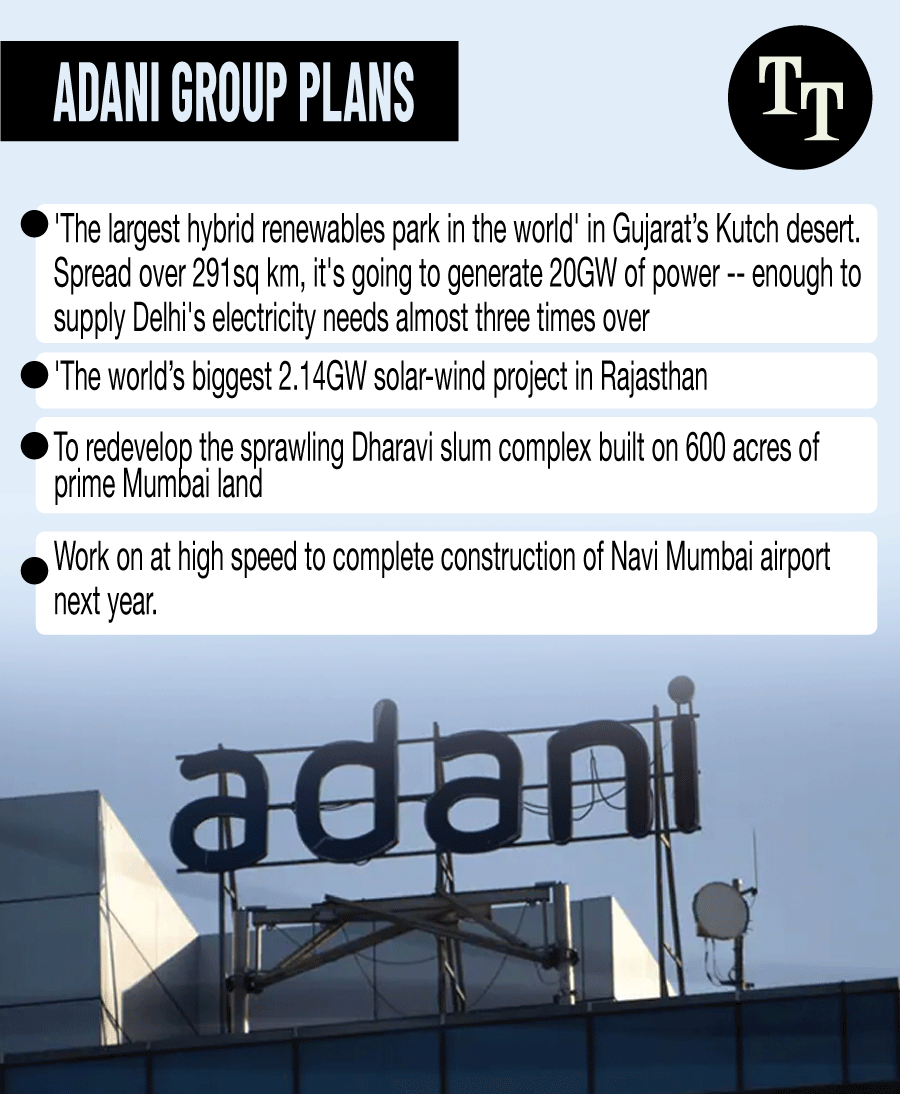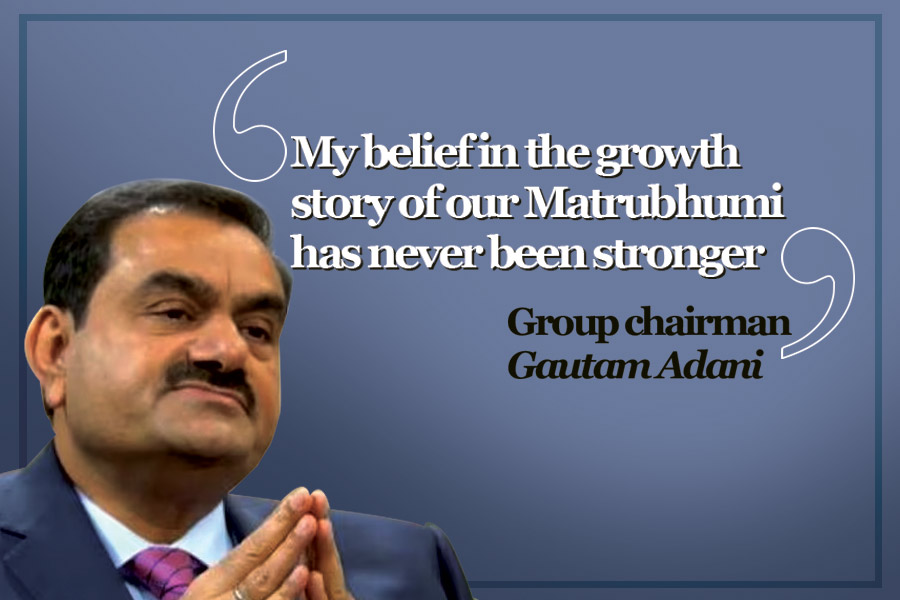Six months after Hindenburg Research triggered a meltdown in Adani shares, the group’s rebounding from the turmoil caused by the US short-seller’s scathing attack on its finances. Its renewables arm, Adani Green Energy, just reported Monday a 50-per-cent leap in first-quarter profit on the back of soaring clean energy sales.
The group’s also planning what it calls “the largest hybrid renewables park in the world” in Gujarat’s Kutch desert. Spread over 291sq km, it's going to generate 20GW of power -- enough to supply Delhi's electricity needs almost three times over. It's also racing ahead with what it says will be the world’s biggest 2.14GW solar-wind project in Rajasthan.
In addition, the conglomerate’s landed a massive contract to redevelop the sprawling Dharavi slum complex built on 600 acres of prime Mumbai land. And it’s working at high speed to complete construction of the Navi Mumbai airport next year. Group chairman Gautam Adani says his confidence in the conglomerate’s prospects are undimmed and “my belief in the growth story of our Matrubhumi has never been stronger.”

TTO graphics
It’s still going to be a long haul before the conglomerate can put the Hindenburg report behind it – in fact that day may never come. The report, which wiped as much as $153 billion off the group's market value in a matter of days, accused the ports-to-power group of “brazen accounting fraud” and share-price manipulation. While the group’s branded the accusations “baseless” and “malicious fabrications”, the report’s explosive contents have meant changes to its ambitious strategy including scrapping some acquisitions and pre-paying debt to allay worries about massive borrowings.
Eye on Sebi's final report
Eyes now are on a final report to be submitted by regulator Sebi to the Supreme Court on August 14 on its investigations into the Hindenburg allegations, but it’s expected to be a damp squib. In fact, so far, things aren’t going too badly for the group.
For instance, it’s just raised Rs 1,250 crore through a local bond sale, the first since the Hindenburg report came out. And some bargain-hunters who decided to buy into the shares when they were at their lowest are sitting on some tidy gains.
Group company shares are still trading well below their pre-Hindenburg peaks. But flagship stock Adani Enterprises, which reported a 137 per cent growth in fourth-quarter net profit to Rs 722 crore, is trading at Rs 2,492. That’s well above its lows of Rs 1,017 touched after the Hindenburg report but still off its all-time high of Rs 4,189 late last year. Adani Green’s shares have more than doubled from their lows to trade at Rs 1,089 but they’re still below pre-report highs of Rs 2,167. Adani Ports and Adani Power are up almost 85 per cent from their worst levels. Gautam Adani is now the world’s 24th richest billionaire at $54 billion (Forbes) after being in number three spot at $143 billion before the Hindenburg claims. But he’s climbed back from the 43rd spot to which he fell after the report came out.
Adani's tangible assets
So how has the Adani empire weathered the Hindenburg earthquake? The group’s commanding presence in the Indian economy has offered a big assist. Adani has tangible assets, mostly in infrastructure, that extend into virtually every nook and cranny of the economy. Adani has the highest market share within the private sector in most of the Indian sectors in which it operates, according to Bloomberg data. For instance, Adani companies handle 43 per cent of all shipping containers, a third of all transported coal and 51 per cent of India’s private electricity transmission. It’s also the biggest private airports and ports player.
The Adani fightback began barely a month after the Hindenburg report came out with roadshows to global financial hubs like Singapore, Dubai, London. The group has aggressively pushed its big-ticket infrastructure projects as being global-scale winners. But the big turnaround moment for the group, though, came in March when seasoned investor Rajiv Jain of US boutique investment firm GQG Partners bought heavily into the conglomerate. Jain, who has a reputation of liking corporate balance sheets to be “bullet proof” told the media the Adani group had “the best infrastructure assets available in India” with “tremendous upside” and this was sufficient justification to take a stake. Jain has since lifted his investment in Adani businesses to nearly $3.5 billion from the $2 billion initial investment he made. Also reassuring investors is Gautam Adani’s perceived closeness to Prime Minister Narendra Modi, though Adani insists he expects and gets no favours from his fellow Gujarati.

The conglomerate’s also been busy getting its debt load under control and says it has all the funds it needs to complete its projects. Adani Ports, for instance, has said it will prepay a $604-million loan that falls due in 2024 and halve capital expenditure. Adani’s paid down other debt and is in talks to refinance more. CreditSights which had called the conglomerate “deeply overaged” last year says there has “been “an improvement in credit metrics for a majority” of the group companies. And Adani is pulling out of some non-core businesses. US private equity group Bain Capital has just agreed to buy Gautam Adani’s 90 per cent stake in Adani Capital and Adani Housing Finance as the tycoon seeks to focus on core infrastructure and energy operations. The Adanis have also made it clear they will not be taking on new road projects, backing out of a Rs 3,110-crore deal with Macquarie Asia Infrastructure Fund to buy two road projects in Gujarat and Andhra Pradesh.
Comeback in fundraising
In the last few months it has been making a comeback in fundraising. Now it’s testing international lender demand for financing of more than $1 billion, according to Bloomberg, to refinance debt it assumed for the purchase of Ambuja Cements and ACC to raise funds for a solar module manufacturing project. More refinancing efforts are on the anvil. The group’s also looking at raising $1.5 billion via Adani Green to fund its planned massive expansion in renewable energy and it’s aiming to rake in $2.6 billion for Adani Enterprises and Adani Transmission. Not all international banks are buying the comeback.
France’s Total has been so rattled by the Hindenburg report it’s put its $50-billion green hydrogen partnership with Adani on hold. Norway’s largest pension fund has exited its investment in Adani Green.
So what has the group’s now got on the anvil? Quite a bit. Its Jharkhand plant has begun transmitting its entire power output to Bangladesh, marking the group’s entry into transnational power projects. Adani met with Bangladesh Prime Minister Sheikh Hasina to mark the event, And it’s announced its $1.1-billion Mundra copper smelter will start production by next March. The group has also just paid $1.2 billion for the redevelopment of Haifa Port in Israel.
$70m investments over next decade
Adani Green aims to invest $70 billion over the next decade in green energy projects from solar cell manufacturing to green hydrogen. Impressively, Adani says Mumbai will get 60 per cent of its power from renewable sources, setting a target of generating 45GW of renewable energy by 2030. That’s considerably more than Pakistan’s total current electricity consumption.
The group’s renewables project planned for the Kutch desert will be spread over a massive 72,000 acres (that’s 291sq kilometres) and will generate 20GW of green energy. “It will be the most complex and ambitious project we have ever executed,” Adani told a recent AGM. “We intend to build it faster than any project in our execution history,” he says. The group currently has an 8GW operational portfolio.
Gautam Adani’s son Karan Adani has been delivering a confident “business as usual” message. The Adani Ports CEO said the group was determined to go ahead with its plans to set up two cement plants in Andhra Pradesh and double capacity at two ports over the next five years. “Not only do we aim to double this capacity, but also transform these ports into industrial port cities,” Karan said.
'Our plans are intact'
In Andhra Pradesh, the group is saying it will go ahead with plans to develop 15,000MW of renewable energy and build a costly 300-megawatt data centre and business park in Vizag. The data centre’s groundbreaking ceremony was held in May and the Adanis are in a 50-50 partnership to develop it with US firm EdgeConneX. Then there’s Adani Total Gas which stayed way ahead of the competition last year and won 14 city licences. It reckons it will spend $1.8 billion in the next seven years. Adani Total’s CEO Suresh P. Manglani told Bloomberg TV, “Our plans are intact… Our expansions are happening and our revenues are building up.”
There’s definitely a lot riding on the way the Adani drama plays out in the coming months, not just for the group but for the country. The group’s a key part of Modi’s “nation-building agenda”. In the 2022 financial year, the Centre for Monitoring Indian Economy said the group accounted for nearly 10 per cent of announced new infrastructure projects. Adani seems well set to ride out the storm.











